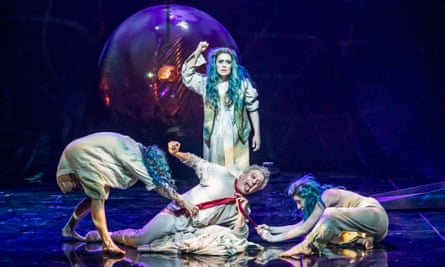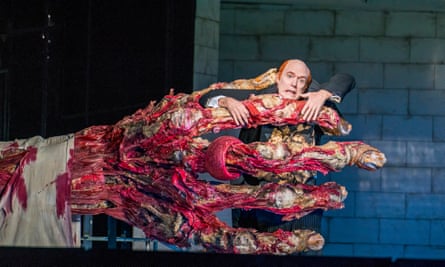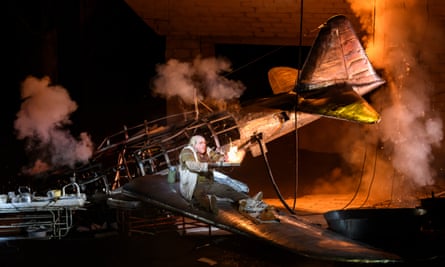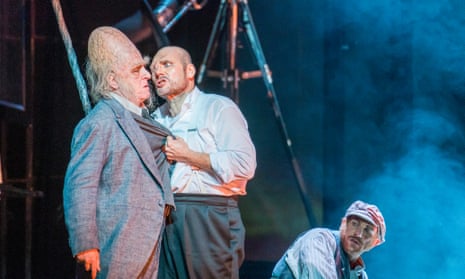I have sung a fair few notes in lots of places, but I am a relative newcomer to Wagner’s vast Ring Cycle. This autumn, I’m singing in my first fully staged production – playing the wily old giant/builder/dragon Fafner at the Royal Opera House in London.
The Ring has always been on my bucket list so I’m more than a little excited. Obviously I’ve tried to look cool and seasoned but in reality I’ve spent most of the rehearsals reminding myself to breathe in and out – because almost everything about this piece is epic.
“Wagner’s vast Ring Cycle,” wrote Gustav Kobbé in The Complete Opera Book, “may or may not be the greatest event inside the form known as opera, but it is certainly the grandest.” He wasn’t wrong. A cycle of four operas totalling at least 15 hours and usually performed in the space of a week, the Ring is the Iron Man challenge of opera.
It’s also the Ben Hur: this production involves hundreds of people both on, off, over and under the stage, with huge sets that do amazing twisty turny things and require huge amounts of space. Usually, the two vast rehearsal studios at the ROH are used to rehearse different operas, but with the Ring both spaces are used all the time, seven days a week, with conductor Tony Pappano and director Keith Warner hotfooting between the two.

Let’s look at the shopping list. We have over 340 props (160 in the Siegfried cycle alone) ranging from a full-sized (crashed) fighter plane to an eight-metre-long sofa, not to mention several golden apples, a skinned toad and a plethora of wigs and prosthetics – including a hugely enlarged head for yours truly.
Fafner is the “brains” of the two brother giants. My grisly swollen head takes over an hour to fit. It is glued in place and then the little veins are painted on. After a while it becomes quite heavy so I have a permanently stiff neck. It has a strange muffling effect on the sound of my voice in my head, akin to singing into a pillow.
What about the performers? There are 31 principal singers, 77 in the chorus, 22 actors, 42 children (with chaperones), and three actors to operate the dragon. The orchestral players do alternate somewhat but there are 107 of them involved both in the orchestra pit and off stage including seven harpists (that’s a lot of space) a contrabass trombone (a lot of pipework), a bass trumpet (a small, accessorised trombone), five steerhorns for the Götterdämmerung part and 12 separate percussionists to whack, in triple time, the 12 anvils that are specifically tuned to F.

The tickets for all 16 performances of this production were sold by the end of the first day, almost a year ago. It seems that rumours of horned helmets (there are none) and numb bottoms have not dimmed the Ring’s appeal. Yes, it is long, but that should perhaps not be such a hurdle, certainly to today’s younger audience members, most of whom will have binge-watched box sets or – like my son and his mates – watched the complete and very Wagnerian Lord of the Rings epics in one sitting.
Some of the Ring’s audience, I know, are fascinated with the deeper themes of Norse mythology. Some just have it on their bucket list. But many will be drawn by the incredible music that fills theatres time and again. It really is overwhelming: 15 hours in this sound world will change your life.
Probably our greatest British Wagnerian singer, Sir John Tomlinson, once said to me that a Wagner singer is a happy singer. This is interesting, as it’s fair to say that not many of Wagner’s characters are particularly balanced or chirpy. But I think I know what John means. Both music and text offer the singer so many opportunities to create something new and vivid – and that is fun and immensely rewarding. Also, the Ring is a team sport, all of the roles being important to the drama. It isn’t like much grand Italian opera, where the singers (and perhaps the audience) are often preoccupied with the big famous aria with the big famous (career-altering) high note.

Of course, there are several more famous moments in the Ring that give the singer something to worry about – like Wotan’s taxing farewell at the end of Die Walküre or the high C at the end of Siegfried that he and Brünnhilde have to dig out when they’ve done quite enough singing – but it’s about the long game. Singing these larger roles is a marathon, definitely not a sprint, and this particular team are among the best in the world. The stamina and shove required for these Herculean roles is simply staggering. Watching the big duets from my seat in the wings is like being courtside for a Nadal v Federer five-setter. There are very few people in the world that can actually get through the ridiculously demanding tenor role of Siegfried and still be able to speak. His relentless “forging song” at the end of Act 1 is a tour-de-force of vocal strength. And that’s just Act 1 – he still has hours to go.
As I’m beheaded about two hours into Siegfried, I get the chance to sit in the wings and actually natter with Siegfried and Brünnhilde before they saunter back on stage to create the exhausting magic of the final scene. Incidentally, if you could spend time backstage during a performance, you would be surprised how calm and business-like it is. I remember discussing home improvements with a colleague. He had laid the bricks for his new conservatory and I had been sanding floors. On another occasion, I was able to recommend a particular lawnmower deal at B&Q to a fellow cast member just before the triumphal scene of Verdi’s Aida.
My most recent “wings” topic – with Wotan and Alberich – was about growing your own vegetables. However, when we eventually lined up on stage for the bows, the warm tidal wave of applause was overwhelming, with over 2,000 people wanting to show us how much they appreciated what we had done.

Comments (…)
Sign in or create your Guardian account to join the discussion